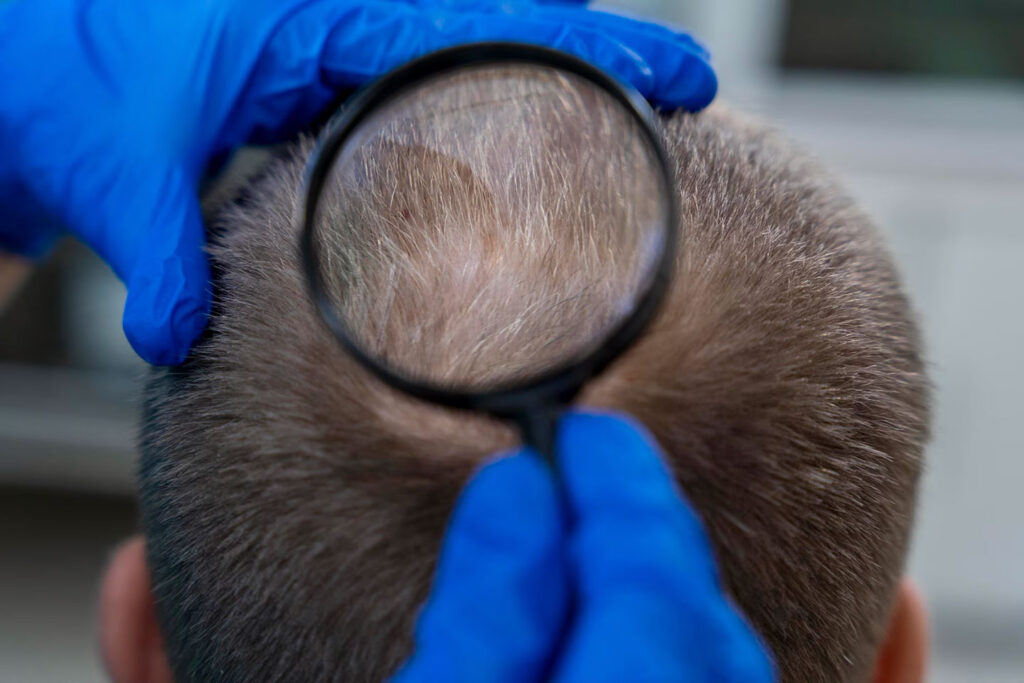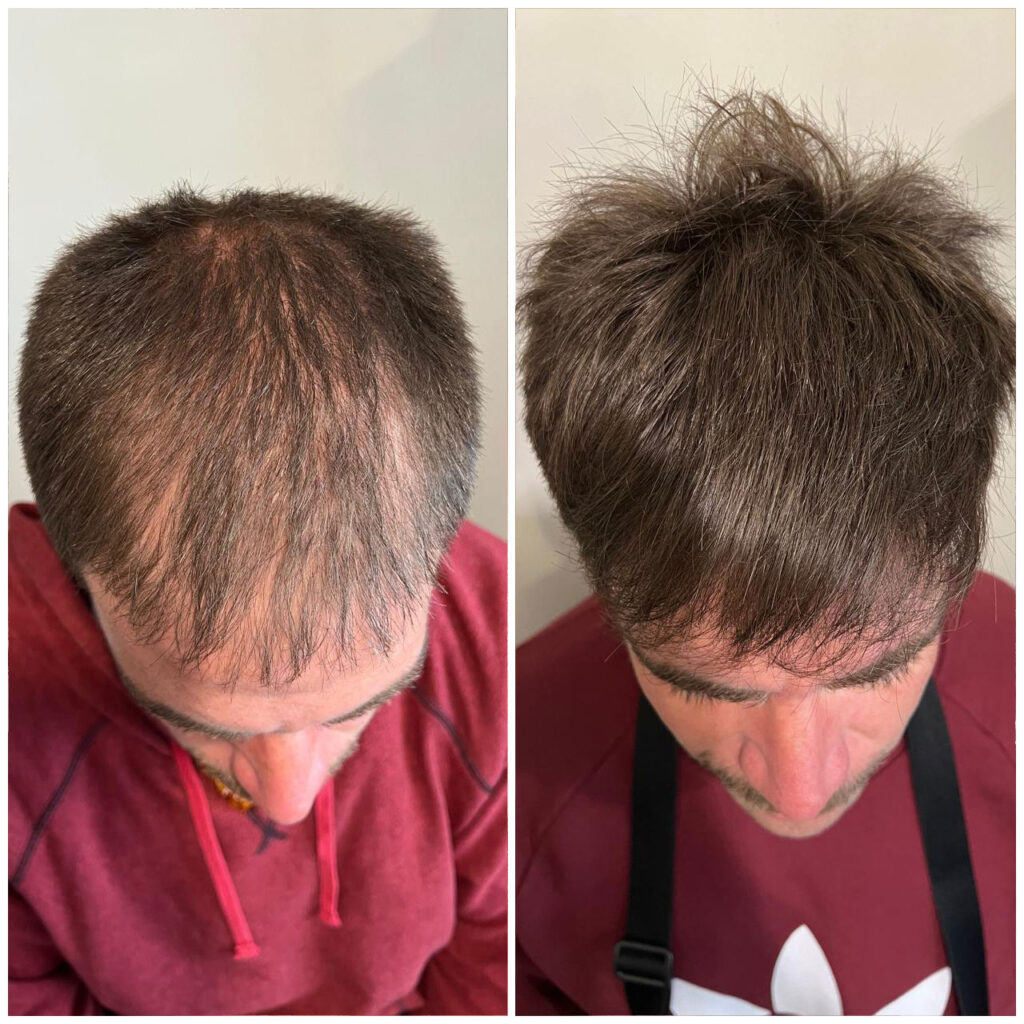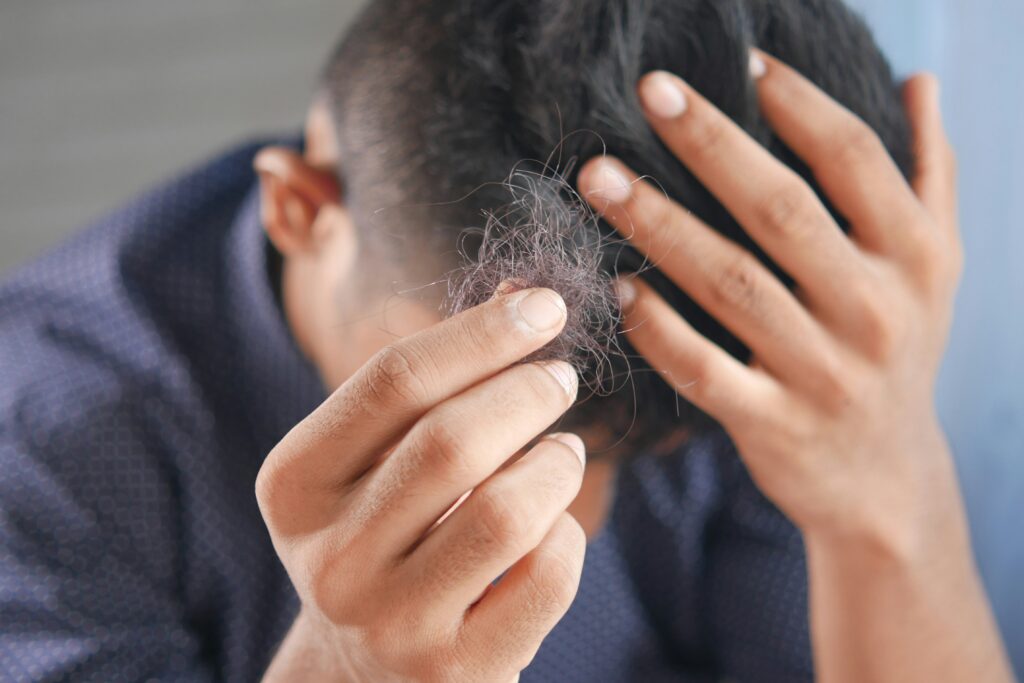Telogen effluvium is a diffuse, transient hair loss that occurs 2–4 months after a physical or hormonal shock (stress, fever, postpartum, surgeries, diets, COVID-19, medications). The follicle is not destroyed and the hair usually regrows when the trigger is corrected. It is not the same as permanent alopecia.
What is telogen effluvium?

Key differences with permanent “alopecia”
- Telogen effluvium (TE): diffuse fall, onset 2–4 months after the trigger, scalp with pores visibleand growing hairs; reversible.
- Androgenetic alopecia (AGA): Thinning progressive and typical pattern (receding hairline/crown in men, widening of the part in women). Responds to continuous treatment.
- Scarring alopecia: inflammation that destroys the follicle and leaves smooth and shiny patches; require early diagnosis and treatment.If you see strands of hair in the shower but your scalp still has pores and new hairs are appearing, consider telogen effluvium. If the area is smooth and poreless, seek urgent medical advice for scarring alopecia.
Most common causes of telogen effluvium
- Postpartum due to a drop in estrogen. It usually resolves within the first year.
- Fever, infections, and COVID-19, surgeries, anesthesia, trauma.
- Intense psychological stress, rapid weight loss, and restrictive diets.
- Deficits (iron, vitamin D, B12) and thyroid deficiencies.
- Medications and hormonal changes, including withdrawal from contraceptives.
Symptoms: How it presents
- Diffuse shedding: more hairs on the pillow, in the shower, and in the brush. It’s normal to lose 50–100/day; in ET, clearly more.
- Delayed onset: at 8–12 weeks after the trigger.
- “Baby hairs” or short growing hair after the shedding phase.
- No defined plaques nor intense itching as a general rule.
How long does telogen effluvium last?
Acuteshedding usually lasts up to 6 months from the start of shedding, with visible recovery in the following months. If it persists >6 months, it is considered chronic and associated causes or persistent triggers must be sought.
Diagnosis in D'Atri: simple and accurate

- Directed story: 3–6 months prior searching triggers (illnesses, births, surgeries, diets, stress, drugs).
- Exam + trichoscopy: growing hair count, minimal diameter variation compared to AGA.
- Additional tests according to the clinic: iron, ferritin, vitamin D, B12, TSH, among others.
- Hair-pull test may be positive during the active phase, although its sensitivity is limited; The wash test and trichoscopy help with follow-up.
Treatment: What to Do and What to Avoid
1) Correct the trigger
Replenish deficits, adjust medications, improve rest and stress management, normalize nutrition and weight. This is the point of greatest impact.
2) Accompany the regrowth cycle
- Topical minoxidil 2–5% can shorten the shedding phase and accelerate turnover in some patients. Particularly useful if shedding impacts quality of life.
- Low-dose oral minoxidil: An alternative in selected cases and under medical supervision; the evidence is emerging and its use is off-label. Individual risk/benefit is assessed.
- Stem Care: Reduce heat and harsh chemicals, low-tension styles.
- Education: ET often resolves on its own when the cause is corrected. Avoid unnecessary invasive treatments.
3) What we don’t recommend as a first line
PRP, systemic corticosteroids, or “megadoses” of supplements without proven deficiency. In non-scarring ET, the focus is time + trigger correction.
Postpartum and post-COVID effluvium: what to expect
- Postpartum: Shedding at 3–4 months after birth; usually normalizes by the first birthday. Avoid traction, ensure rest, and seek medical attention if it persists >12 months.
- Post-COVID: Diffuse TE is common after infection; most recover density over time with conservative management.
Prevention and habits
- Complete diet and laboratory controls if there is suspicion of deficiency.
- Management of stress and sleep.
- Avoid extreme diets and sudden weight loss.
- Reduce heat and chemicals and alternate hairstyles without tension.
Frequently Asked Questions About Telogen Effluvium
Hair treatments at D'Atri Medicina Capilar

At D’Atri Medicina Capilar we evaluate causes and triggers, we perform trichoscopy and we request oriented laboratory when appropriate. We give you a clear plan to stop shedding, shorten recovery times and rule out pathologies that require another approach. If AGA coexists, we add specific treatment to protect and thicken the skin.
Book your diagnosis with our hair dermatology team.

